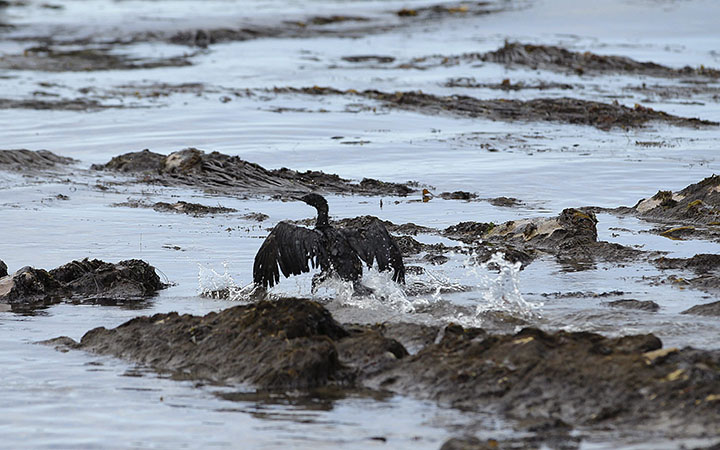LOS ANGELES – Firefighters investigating a reported petroleum stench at a California beach last month didn’t take long to find a spill – oil was spreading across the sand and into the surf. Tracing the source, they found crude gushing from a bluff like a fire hose “without a nozzle,” records show.

But critical time would elapse before the operator of a nearby pipeline confirmed that it had ruptured and spewed the oil. An employee at the scene for Plains All American Pipeline initially suggested to firefighters that the spill “was too big to be from their pipeline,” according to the documents obtained by The Associated Press.
READ MORE: Workers clean up oil spill on California beaches by hand
The description of what firefighters found May 19 at Refugio State Beach was detailed in records Santa Barbara County firefighters filed with state officials. It indicates that firefighters who arrived just before noon quickly recognized that “some sort of leak or spill had occurred.”
A Plains company spokeswoman would not comment Thursday on why it took until later in the afternoon for its workers to confirm the line was cracked and spilling thousands of gallons of oil onto the sand and water west of Santa Barbara.
Plains is facing scrutiny from federal regulators and lawmakers over the spill, which washed up goo on beaches as far as 100 miles away.
The failed pipeline released up to 101,000 gallons, and an estimated 21,000 gallons reached the water.
The U.S. House Energy and Commerce Committee opened an investigation Thursday and asked the company for detailed information on maintenance of the line, including how it addressed corrosion. The panel also wants the company to explain what it did in the hours leading up to the break and how it reported the problem.
A key issue has been how long it took the Texas-based company to relay information on the break to the federal government. Internal planning documents stress the importance of notifying the government of a leak as quickly as possible.
Federal regulations require the company to notify the National Response Center, a clearinghouse for reports of hazardous-material releases, “at the earliest practicable moment.” State law requires immediate notification of a release or a threatened release.
WATCH: California coast oil spill nightmare after pipeline ruptures
Company employees at the scene did not confirm a leak until about 1:30 p.m., and it would be nearly 3 p.m. before the company would contact the response centre. By then, the federal response led by the Coast Guard was underway.
The federal Pipeline and Hazardous Materials Safety Administration is investigating the cause of the accident. The agency released preliminary findings earlier this month that the break occurred along a badly corroded section that had worn away to a fraction of an inch in thickness.
In a separate letter Thursday, the House committee asked the pipeline administration for an update of what it called long overdue pipeline safety rules. The panel said the California spill raised questions about the agency’s oversight of pipeline safety and added that the agency had failed to complete 17 of 42 requirements Congress outlined in 2011 to help prevent spills.
Cleanup costs have reached $92 million.
Federal elected officials released records from Plains All American on Wednesday that provided a look inside a company trying to contend with what became the largest coastal oil spill in California in 25 years.
Those records said that once company workers confirmed oil was in the ocean, two employees rode along the pipeline to look for a source. “It was not readily apparent from their vantage point near the beach that the oil originated” from the company pipeline, they said.
It was later determined the oil travelled to the beach down a culvert near the break. By the time company employees confirmed the spill, it was at least an hour after firefighters reported oil on the beach.
Plains spokeswoman Meredith Matthews said Wednesday that company personnel were on the beach with firefighters around the same time local officials alerted the response centre to the spill. “The response was not delayed,” she said.
READ MORE: Investigation into cause of broken California oil pipeline could take months
Popular campgrounds have been closed, nearby commercial fishing has been prohibited and nearly 300 marine mammals and birds have been found dead after the spill.
At a state legislative hearing Friday in Santa Barbara, Janet Wolf, chair of the county board of supervisors, said county officials were concerned the pipeline company was exerting too much influence on operations following the spill, while local officials were being excluded.
She said Plains All American executives were allowed “to make whatever statements or representations they wanted” at news conferences following the spill, while the county’s statements were vetted.
“They are embedded in every aspect of operations and meetings that even I, a local elected official … was not permitted to attend,” Wolf said.
- Ontario First Nation calls for chemical plant to be shut down amid ‘dangerously high’ benzene levels
- Nova Scotia scraps spring bear hunt idea, public ‘very divided’ on issue
- Ottawa looks to launch national flood insurance program within 12 months
- Ecuador rations power, declares emergency as drought limits hydro output



Comments